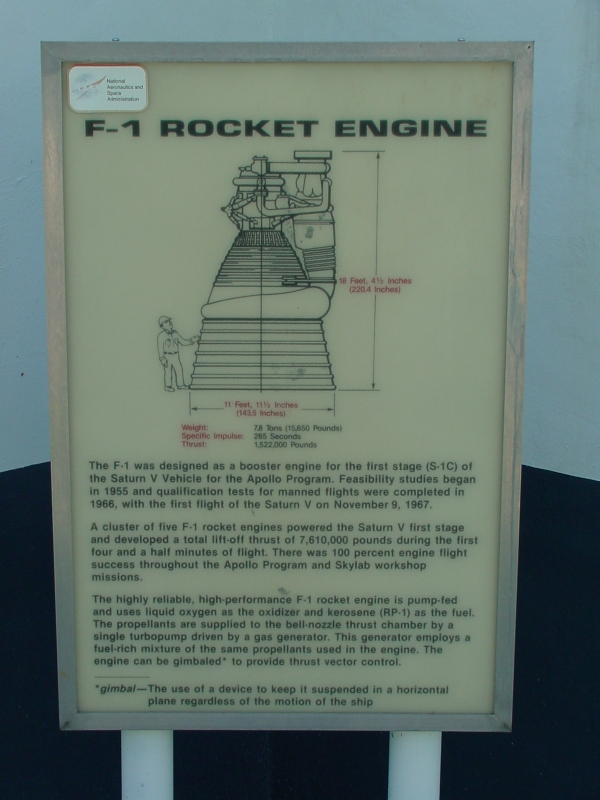| Prev |
heroicrelics.org Stennis Space Center Site Index F-1 Engine Gallery |
Next |
dsc06476.jpg
The sign accompanying the F-1 engine. It reads
F-1 Rocket Engine
The F-1 was designed as a booster engine for the first stage (S-IC) of the Saturn V Vehicle for the Apollo Program. Feasibility studies began in 1955 and qualification tests for manned flights were completed in 1966, with the first flight of the Saturn V on November 9, 1967.
A cluster of five F-1 rocket engines powered the Saturn V first stage and developed a total lift-off thrust of 7,610,000 pounds during the first four and a half minutes of flight. There was 100 percent engine flight success throughout the Apollo Program and Skylab workshop missions.
The highly reliable, high-performance F-1 rocket engine is pump-fed and uses liquid oxygen as the oxidizer and kerosene (RP-1) as the fuel. The propellants are supplied to the bell-nozzle thrust chamber by a single turbopump driven by a gas generator. This generator employs a fuel-rich mixture of the same propellants used in the engine. The engine can be gimballed* to provide thrust vector control.
-----------------
* gimbal - The use of a device to keep it suspended in a horizontal plane regardless of the motion of the ship
The sign also notes that the engine is 18 feet, 4½ inches (220.4 inches) from the top of the interface panel to the exit plane and 11 feet, 11½ inches (143.5 inches) in diameter at the nozzle extension exit plane.
It also notes the following statistics:
| Weight: | 7.8 tons (15,650 pounds) | |
| Specific Impulse: | 265 seconds | |
| Thrust: | 1,522,000 pounds |
I'm surprised that they failed to mention that the "first flight of the Saturn V on November 9, 1967" flew Apollo 4, which resides at Stennis.

| Time picture taken | Fri Jun 18 09:58:34 2004 |
| Location picture taken | Rocket Park Visitor Center Stennis Space Center, MS |
| Prev | F-1 Engine Gallery | Next |